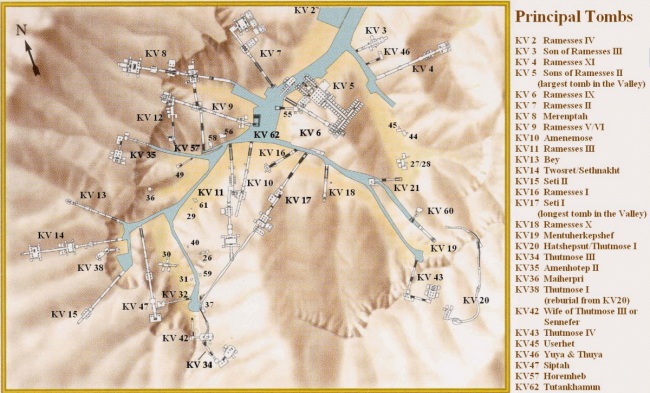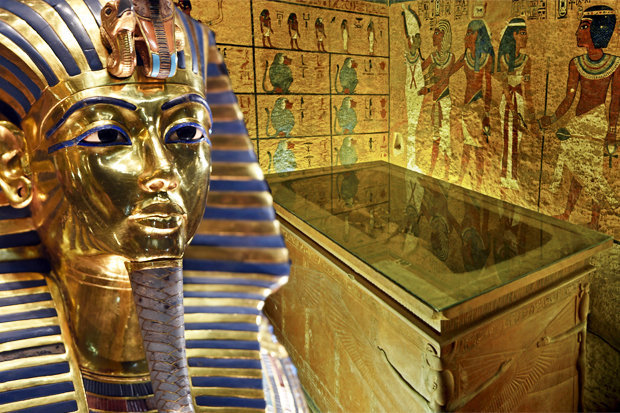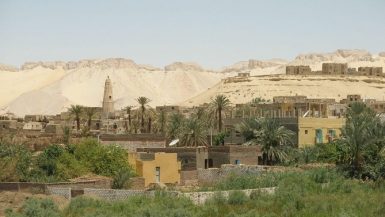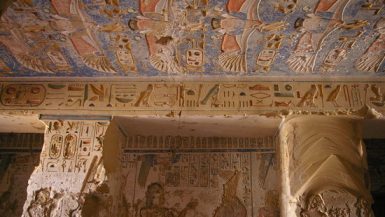Valley of the Kings | Ankh |
Nestled in the cliffs on the west bank of the Nile at Luxor, the isolated Valley of the Kings is home to the tombs of the great pharaohs of the New Kingdom (1550 – 1070 BC).
They are hidden within a wadi (or valley) formed over millennia by rainfall and water runoff.
The first known pharaoh known for certin to have built a tomb within the valley was Hatshepsut, although many Egyptologists believe that Thutmose I was the first to locate his tomb here.
The Valley of the Kings
The Valley of the Kings is divided into two main branches: the more famous East Valley and the West Valley. Steep cliffs define the latter’s topography, in which only 3 tombs have been found including the Tomb of Ay (KV 23).
The eastern valley, covering 2 hectares, resembles a hand with splayed fingers. To the south, towering over the valley, is a peak shaped like a pyramid, known as el-Qurn (the horn). Archaeologists believe that this natural feature influenced the choice of this site for the royal tombs.
Valley of the Kings Tombs
There are 63 known tombs in the Valley of the Kings, 26 carved for kings and the others granted to royal family members or the highest of the elite.
15 Of these, are currently open to the public: Ramesses I, Ramesses III, Ramesses IV, Ramesses V/VI, Ramesses VII, Ramesses IX, Seti II, Siptah, Merenptah, Thutmose III, Thutmose IV, Mentuherkhepshef, Tausret/Sethnakht, Ay, and Tutankhamun.
They were carved out of the cliffs as long shafts, heading deep underground and terminating in elaborate burial chambers.
The tombs in Valley of the Kings are decorated from top to bottom with religious images and texts from the netherworld books, designed to aid the journey of the king to the afterlife.
Valley of the Kings facts
Many famous adventurers and archaeologists have explored the valley, including engineer and circus strongman Giovanni Belzoni, and artist/Egyptologist Howard Carter, who is famous for finding the tomb of Tutankhamun in 1922.
Recent discoveries in the Valley of the Kings include KV 5, which was re-excavated by Dr. Kent Weeks in 1995, found to be much more extensive than previously thought, and identified as the tomb of the sons of Ramesses II; and KV 63, a cache of late 18th Dynasty material, unearthed by Dr. Otto Schaden.
Dr. Zahi Hawass is currently leading the first all-Egyptian team to excavate in the valley; he is exploring the tunnel in the tomb of Seti I and attempting to locate the missing tomb of Ramesses VIII.
Valley of the Kings Map

Location and Directions
LOCATION: West Bank, Luxor
BY TAXI: ask for “wadi al-maluk” for the East Valley (KV), and “wadi al-gurub” for the West Valley (WV), also known as the “Valley of the Kings.”
Valley of the Kings Ticket Prices
Open daily: 6:00 AM – 7:00 PM
TICKET COST
General Admission: Includes admission to the area and to THREE of the following tombs, which are open to the public: Ramesses I, Ramesses III, Ramesses IV, Ramesses VII, Ramesses IX, Seti II, Siptah, Merenptah, Thutmose III, Thutmose IV, Mentuherkhepshef, Tausret/Sethnakht.
Egyptian: 20 LE
Egyptian Student: 10 LE
Foreign: 160 LE
Foreign Student: 80 LE
Train: 5 LE
Tickets for the tomb of Tutankhamun, and Ay must be purchased separately (see below for details).
Egyptian: 10 LE
Egyptian Student: 5 LE
Foreign: 80 LE
Foreign Student: 40 LE
Student rates are available to bearers of a valid student ID from an Egyptian university or an International Student ID Card.






Leave a reply